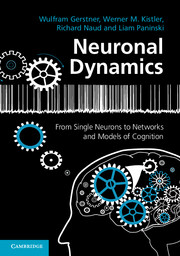Book contents
- Frontmatter
- Contents
- Preface
- PART ONE FOUNDATIONS OF NEURONAL DYNAMICS
- 1 Introduction: neurons and mathematics
- 2 Ion channels and the Hodgkin–Huxley model
- 3 Dendrites and synapses
- 4 Dimensionality reduction and phase plane analysis
- PART TWO GENERALIZED INTEGRATE-AND-FIRE NEURONS
- PART THREE NETWORKS OF NEURONS AND POPULATION ACTIVITY
- PART FOUR DYNAMICS OF COGNITION
- References
- Index
1 - Introduction: neurons and mathematics
Published online by Cambridge University Press: 05 August 2014
- Frontmatter
- Contents
- Preface
- PART ONE FOUNDATIONS OF NEURONAL DYNAMICS
- 1 Introduction: neurons and mathematics
- 2 Ion channels and the Hodgkin–Huxley model
- 3 Dendrites and synapses
- 4 Dimensionality reduction and phase plane analysis
- PART TWO GENERALIZED INTEGRATE-AND-FIRE NEURONS
- PART THREE NETWORKS OF NEURONS AND POPULATION ACTIVITY
- PART FOUR DYNAMICS OF COGNITION
- References
- Index
Summary
The primary aim of this chapter is to introduce several elementary notions of neuroscience, in particular the concepts of action potentials, postsynaptic potentials, firing thresholds, refractoriness, and adaptation. Based on these notions a preliminary model of neuronal dynamics is built and this simple model (the leaky integrate-and-fire model) will be used as a starting point and reference for the generalized integrate-and-fire models, which are the main topic of the book, to be discussed in Parts II and III. Since the mathematics used for the simple model is essentially that of a one-dimensional linear differential equation, we take this first chapter as an opportunity to introduce some of the mathematical notation that will be used throughout the rest of the book.
Owing to the limitations of space, we cannot – and do not want to – give a comprehensive introduction to such a complex field as neurobiology. The presentation of the biological background in this chapter is therefore highly selective and focuses on those aspects needed to appreciate the biological background of the theoretical work presented in this book. For an in-depth discussion of neurobiology we refer the reader to the literature mentioned at the end of this chapter.
After the review of neuronal properties in Sections 1.1 and 1.2 we will turn, in Section 1.3, to our first mathematical neuron model. The last two sections are devoted to a discussion of the strengths and limitations of simplified models.
Information
- Type
- Chapter
- Information
- Neuronal DynamicsFrom Single Neurons to Networks and Models of Cognition, pp. 3 - 27Publisher: Cambridge University PressPrint publication year: 2014
Accessibility standard: Unknown
Why this information is here
This section outlines the accessibility features of this content - including support for screen readers, full keyboard navigation and high-contrast display options. This may not be relevant for you.Accessibility Information
- 2
- Cited by
